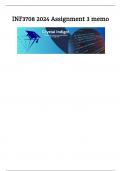INF3708 2024 Assignment 3 memo
Crystal Indigo!
Providing all solutions you need anytime
+27 76 626 8187
, Question 1
1.1 Discuss two risks that the delivery service might potentially encounter when
delivering a meal to a low socio-economic area.
i. Higher crime rates and unsafe neighbourhoods in low socio-economic areas pose
threats to delivery personnel and the meals being delivered.
ii. Poor infrastructure, such as badly maintained roads and insufficient street signage,
can make navigation and reaching beneficiaries challenging for delivery vehicles.
1.2 Recommend risk mitigation features that can be build into the service delivery
application to prevent the risks that you identified in Question 1.1.
i. Implement safety measures for delivery personnel, including real-time tracking,
emergency alert buttons, and direct communication channels with local authorities.
ii. Utilize GPS technology to plan efficient delivery routes, avoiding high-risk areas and
reducing travel time.
1.3.1 Describe cost implications if the risk materialises.
i. Increased insurance premiums due to higher rates of accidents and crime.
ii. Expenses related to repairing vehicles damaged by poor road conditions.
iii. Costs incurred from undelivered meals due to safety concerns or accessibility
issues, including wasted food, fuel, and delivery personnel time.
1.4 Justify features that can be incorporated into Culinary Bargain’s online
marketplace to allow the beneficiary to cover the travel expense by either own
transport or mini-bus taxi.
i. Transport Subsidies: Enable beneficiaries to use a portion of their hunger relief
coupon value to cover transportation costs (e.g., bus fare, taxi).
ii. Flexible Pickup Options: Provide multiple collection points (e.g., community centers,
local shops) to reduce travel distances.
iii. Partner with rideshare services to offer subsidized rides to and from the
restaurant.
iv. Allow beneficiaries to pool resources to share the cost of private transportation, such
as minibus taxis.




